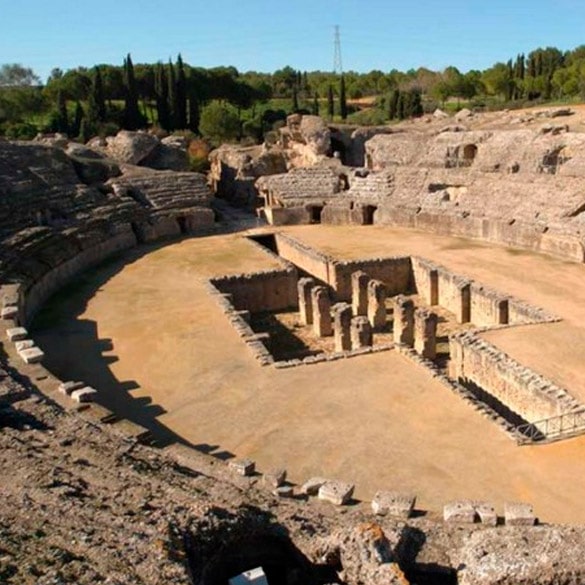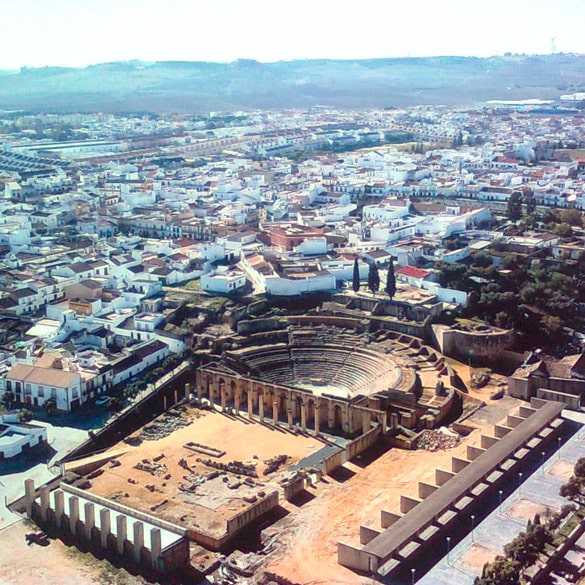More history
Itálica was the first Roman city founded in Hispania and also outside Italian territory. At the end of the Second Punic War in Hispania, Publius Cornelius Scipio the African settled the wounded soldiers in a pre-existing turdetan city, whose original name is unknown, in the upper area of Aljarafe, on the west bank of the Baetis River, located halfway road between the also turdetan cities of Hispalis (Seville) and Ilipa (Alcalá del Río, SE), and probably port. The text of Appian of Alexandria where this is related, (Iberiké, 38) allows to deduce that the origin of said soldiers was fundamentally Italian, that is, of auxiliary italic units, and hence the name chosen by Scipio.
Possibly the legal status of the city, shortly after its founding, was that of the Latin colony, and the plant of the original city already of the camp type (hypodamic), as was the custom in the military colonies of the time in It must have been at the end of Julio César's last stay in Hispania, in 45 BC, when Italica obtained from him the legal status of municipium civium Romanorum, possibly as a reward for the support of the city against Pompey in the recent civil war, although he did not mint coins as such until the time of Augustus, when a mint was created where bronze coins of different values were minted, with the effigy of Augustus and later of Tiberius on the obverse, while the reverse of these co-payments are exceptional in the panorama of the Hispanic women due to the great "romanidad" of their subjects.
The city reached its period of greatest splendor at the end of the first century and during the second century, from the reigns of Trajan and Adriano, the two born in Itálica, which would greatly strengthen the undoubted prestige that already had in Rome the old Hispanic colony. Both emperors, who undoubtedly owed much of their rise to the throne to the important Spanish pressure group existing in the Roman senate since at least the time of Claudius and Nero, were particularly generous with their hometown, expanding and revitalizing their economy. Adriano was the one who granted him the rank of colony after the inhabitants asked for it, the emperor also embellished it with excellent public buildings.
Although perhaps already begun under Trajan, it is literary proof (Dion Casio LXIX, 10, 1) and epigraphically the participation of Adriano in the great urban expansion towards the north -also hypodamic, like its predecessor- that was baptized in 1960 by García and Bellido as Nova urbs or "new city", which only had a really splendid existence during the second century, at the end of which, and without ever having been completed, began its decline, for reasons certainly political-economic. of the city that is currently the Archaeological Ensemble of Itálica, unparalleled because of its huge mansions paved with mosaics, or its great (though very destroyed) amphitheater, room of the Empire for its capacity. The "old city" or Vetus urbs is under the urban center of the current town of Santiponce (founded in 1601, after successive floods of the river, closer to which it was originally located), since this part of the city is the most continuity had, reaching the times of the Muslim occupation when it took place, in the tenth century, its permanent depopulation and abandonment. There are very few known Roman remains of it, the main ones of which are the theater and the so-called "minor baths" or "Trajan".
It is during the rule of Adriano when the city itself requests the emperor, and against his advice, as recounted by Aulus Gelio (Noct.Attic.16, 13, 4), to change its advantageous Roman municipal statute to that of the Roman colony, heavier but more prestigious, because they were simulated Romae ("mirrors of Rome") and as an ideal part or extension of the Urbs itself. As a result of this concession it was renamed Colonia Aelia Augusta Italica, in honor of Adriano, titles that usually appear abbreviated as C.A.A.I.







